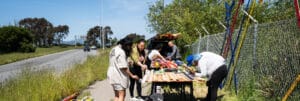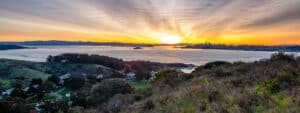By Mark Padro
Marin has the highest percentage of land protected from development in the Bay Area, and should focus future development near Highway 101 and transportation centers, according to a new report by Greenbelt Alliance, a San Francisco-based advocacy group.
Marin is home to national, state and county parks that have helped it protect 56 percent its 333,000 acres from development. The Marin Agricultural Land Trust, which has conservation easements of more than 44,100 acres on 68 family farms and ranches, has also played a role, according to the report: “At Risk: The Bay Area Greenbelt.”
San Mateo County is second behind Marin, with 38 percent of its land permanently protected. If public policy protections are considered, such as zoning rules, 85.5 percent of Marin’s lands are protected from development, according to Greenbelt.
While Marin standouts in land protection, its hillsides are still vulnerable to the construction of sprawling “McMansions.” While that type of home building is not desired, that doesn’t mean there shouldn’t be development in the county, according to the report.
“The lack of home choices has made Marin the regional leader in ‘in-commuters,’ with 60 percent of its workforce driving in from other counties,” according to the report. “To give employees the chance to live locally, new development needs to be near 101 and future Sonoma-Marin Area Rail Transit stations. The county’s largest challenge is to communicate to residents the benefits more homes will have on the environment and the economy.”
Novato resident Marla Fields, a member of the housing advocacy group Stand Up for Neighborly Novato, said there should be more home choices in the county.
“I hear so many sad stories of people who are suffering due to the high cost of rents in Marin,” Fields said in the report. “Even at a visit to my Novato dentist, the office assistant told me she would love to move from Santa Rosa to Novato, but as a single mom, she cannot afford to rent in Novato.”
Providing more homes will improve the air quality in Marin and allow working farms and protected parks to thrive, according to the report.
“The county plan defines where urban and rural growth would happen,” said Adam Garcia, Greenbelt policy researcher who helped produce the report. “They have focused growth along the urban corridor. It makes sense and is effective policy.”
Much of the Bay Area is following Marin’s example of protecting its greenbelt.
The report found that more than 3 million of the 4.5 million acres of the region’s landscapes are protected in some form. About one-third of that is permanently preserved and two-thirds are protected by growth management measures.
Despite that success, some pressure to develop remains. More than 322,000 acres remain at risk — more than 10 times the size of San Francisco, according to the report.
“The Bay Area has made good progress since we released our first ‘At Risk’ report in 1989,” said Jeremy Madsen, executive director of Greenbelt Alliance. “The good news is that development patterns have been shifting from sprawl toward a smart growth future.”
For maps on Bay Area greenbelts that face development threats, visit:http://www.greenbelt.org/greenbelt-mapper




